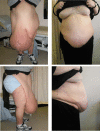Panniculus morbidus: obesity-related abdominal wall lymphoedema
- PMID: 28456757
- PMCID: PMC5534659
- DOI: 10.1136/bcr-2016-219023
Panniculus morbidus: obesity-related abdominal wall lymphoedema
Abstract
A 52-year-old female patient presented with a massive abdominal wall swelling that adversely affected her lifestyle. Imaging revealed significant subcutaneous oedema and the presence of grossly distended veins. Subsequently, she underwent a 'toilet' panniculectomy and abdominoplasty. We describe the surgical technique used to retract the lymphoedematous tissue facilitating excisional surgery, and discuss the pathophysiology of this condition and the possible contribution of venous obstruction to the development of subcutaneous oedema.
Keywords: General surgery; Obesity (nutrition); Obesity (public health); Plastic and reconstructive surgery.
© BMJ Publishing Group Ltd (unless otherwise stated in the text of the article) 2017. All rights reserved. No commercial use is permitted unless otherwise expressly granted.
Conflict of interest statement
Competing interests: None declared.
Figures



Similar articles
-
Integrated concept of treatment for reduction of morbidity after resection of panniculus morbidus associated with lymphoedema.J Plast Surg Hand Surg. 2012 Sep;46(3-4):172-6. doi: 10.3109/2000656X.2012.700007. J Plast Surg Hand Surg. 2012. PMID: 22909237
-
Suspension of panniculus morbidus: heavy lifting made easy.Surg Obes Relat Dis. 2013 Jul-Aug;9(4):586-7. doi: 10.1016/j.soard.2013.04.002. Epub 2013 Apr 15. Surg Obes Relat Dis. 2013. PMID: 23763939 No abstract available.
-
Reconstruction of massive localised lymphoedema of the scrotum with a novel fasciocutaneous flap: A rare case presentation and a review of the literature.J Plast Reconstr Aesthet Surg. 2013 Feb;66(2):281-6. doi: 10.1016/j.bjps.2012.06.024. Epub 2012 Aug 4. J Plast Reconstr Aesthet Surg. 2013. PMID: 22867984 Review.
-
Massive panniculectomy results in improved functional outcome.Am J Surg. 2014 Mar;207(3):441-4; discussion 444. doi: 10.1016/j.amjsurg.2013.09.010. Epub 2013 Dec 19. Am J Surg. 2014. PMID: 24439157
-
Management of skin and subcutaneous tissue in complex open abdominal wall reconstruction.Hernia. 2018 Apr;22(2):293-301. doi: 10.1007/s10029-017-1662-3. Epub 2017 Sep 4. Hernia. 2018. PMID: 28871371 Review.
Cited by
-
Novel use and utilization of robotic Hoyer-Hook system for suspension of panniculus morbidus.JPRAS Open. 2023 Jun 26;37:87-91. doi: 10.1016/j.jpra.2023.06.011. eCollection 2023 Sep. JPRAS Open. 2023. PMID: 37457989 Free PMC article.
-
Panniculus morbidus resection complicated by multiple gastrointestinal hernias: A case report.Ann Med Surg (Lond). 2022 Jul 16;80:104177. doi: 10.1016/j.amsu.2022.104177. eCollection 2022 Aug. Ann Med Surg (Lond). 2022. PMID: 36045791 Free PMC article.
-
Panniculectomy for a Rare End-Stage Complication of Severe Obesity and Increasing Surgical Phenomenon.Cureus. 2024 Apr 4;16(4):e57592. doi: 10.7759/cureus.57592. eCollection 2024 Apr. Cureus. 2024. PMID: 38707026 Free PMC article.
-
Manifestations and etiology of cutaneous findings in cases of morbid obesity.Forensic Sci Med Pathol. 2024 Dec;20(4):1475-1482. doi: 10.1007/s12024-023-00721-3. Epub 2023 Oct 27. Forensic Sci Med Pathol. 2024. PMID: 37889417 Free PMC article. Review.
-
Massive Localized Abdominal Lymphedema Treatment Challenges.Plast Reconstr Surg Glob Open. 2020 Jan 17;8(1):e2601. doi: 10.1097/GOX.0000000000002601. eCollection 2020 Jan. Plast Reconstr Surg Glob Open. 2020. PMID: 32095405 Free PMC article.
References
-
- Health and Social Care Information Centre. Statistics on obesity, physical activity and diet. 2016:1–20.
Publication types
MeSH terms
LinkOut - more resources
Full Text Sources
Other Literature Sources
Medical
